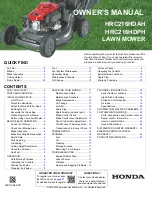
6
BEFORE EACH OPERATION
Your safety is your responsibility. A little time spent in preparation will
significantly reduce your risk of injury.
Read and understand this manual. Know what the controls do and
how to operate them.
Familiarize yourself with the lawn mower and its operation before you
begin using it. Know how to quickly shut off the lawn mower in case of
an emergency.
Check Your Mower
For your safety, and to maximize the service life of your lawn mower, it
is very important to take a few moments before you operate the lawn
mower to check its condition. Be sure to take care of any problem you
find, or have your servicing dealer correct it, before you operate the
lawn mower.
• Make sure the lawn mower is on a level surface
• Look around and underneath the lawn mower for signs of oil or
gasoline leaks
• Look for signs of damage
• Check each control for proper operation
• Check the blades for wear. Replace as necessary (
• Check that the blade bolts are tight (
)
• Check that all nuts, bolts, and screws are tightened
• Check the air filter (
) and oil level (
• Check the fuel level (
). Starting with a full tank will help to
eliminate or reduce operating interruptions for refueling.
Check Your Mowing Area
For your safety and the safety of others, always inspect the area
before operating the lawn mower.
Anything that can be picked up by the blades and thrown is a potential
hazard to you and others. Look for things like stones, sticks, nails, and
wire, and remove them from the lawn area.
People and animals near the lawn area can move into your lawn
mower’s path or into a position where they could be struck by thrown
objects. Clear the area of pets and people, especially children. Their
safety is your responsibility.
Check the condition of the grass. Adjust your lawn mower ground
speed and mowing swath accordingly.
Blade Inspection
1. Turn the fuel valve OFF (
2. Disconnect the spark plug cap from the spark plug (
3. Tilt the mower to the right side so that the fuel cap side is up. This
will help to prevent fuel leakage and hard starting due to carburetor
flooding.
4. Inspect the blades for damage, cracks, and excessive rust or
corrosion.
A dull blade can be sharpened, but a blade that is excessively worn,
bent, cracked, or otherwise damaged must be replaced.
If a blade is bent, take the lawn mower to an authorized Honda
servicing dealer for inspection.
Blade Mounting Bolt Inspection
Inspect the blade bolts for any signs of damage
or looseness. If they are damaged, they must
be replaced.
If they appear loose, a torque wrench must be
used to accurately tighten the blade bolts to the
required torque. If you do not have a torque
wrench, take your lawn mower to an authorized
dealer to have the bolts replaced or tightened.
Use only Honda Genuine blade bolts and
special washers, since they are specifically
designed for this purpose. Replacement part
WARNING
Exhaust contains poisonous carbon monoxide gas that
can build up to dangerous levels in closed areas.
Breathing carbon monoxide can cause unconsciousness
or death.
Never run the lawn mower in a closed, or even partially
closed area where people may be present.
WARNING
A worn, cracked, or damaged blade can break, and
pieces of the damaged blade can become dangerous
projectiles.
Blades thrown from the mower could seriously hurt or kill
someone.
Inspect the blades regularly, and do not operate the
mower with worn or damaged blades.
BLADE BOLTS
BLADES
NORMAL
WORN
BENT
CRACKED
NORMAL
TRAILING EDGE
EXCESSIVELY WORN
TRAILING EDGE
Inspect washers
and bolt heads for
looseness or
damage.
Summary of Contents for HRC216HDAH
Page 25: ...25 NOTES...
Page 26: ...26 NOTES...







































